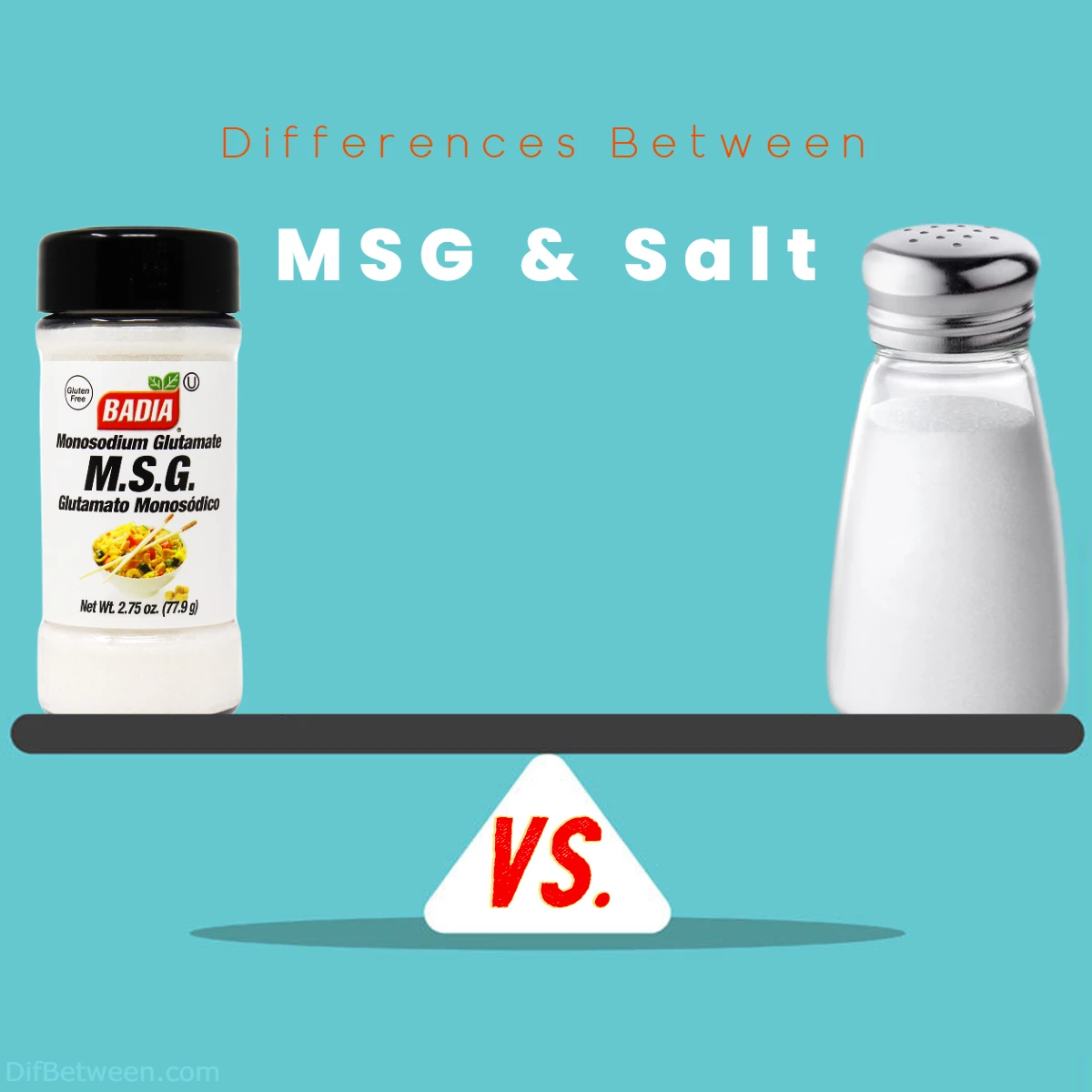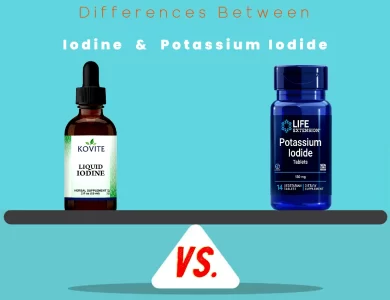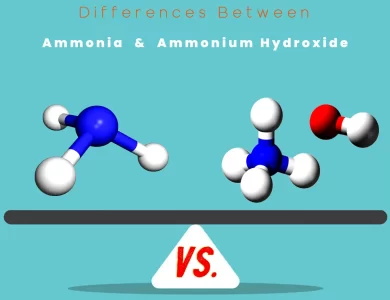
| Aspect | MSG | Salt |
|---|---|---|
| Composition | Sodium and glutamate | Sodium and chlorine (sodium chloride) |
| Flavor Role | Enhances specific flavors (umami) | Enhances overall taste perception |
| Texture | Doesn’t alter texture directly | Enhances crunch, tenderness, and mouthfeel |
| Health | Generally safe in moderation | Excessive consumption linked to health issues |
| Myths | Misunderstood and surrounded by myths | Commonly used but excessive intake is a concern |
| Scientific | Umami discovery led to MSG’s synthesis | Ongoing research on salt’s health effects |
| Production | Synthesized in laboratories | Naturally occurring and mined |
| Innovation | Enhancing flavor complexity and depth | Exploring ways to reduce sodium in foods |
| Culinary Role | Enhances umami, elevates complexity | Controls flavor, enhances, preserves |
| Culinary Examples | Umami-rich dishes like broths and stews | Across all cuisines, in sweet and savory |
| Cooking Tips | Use in moderation, pair with umami-rich ingredients, taste while cooking | Layering, finishing, experimenting with different types of salt |
These two elements might seem simple, yet they hold the power to transform bland into brilliant, dull into delightful. In this insightful exploration, we’ll uncover the distinct characteristics of MSG and salt, shedding light on their differences and how they impact our palates and health. So, grab your aprons and let’s season our minds with knowledge!
Differences Between MSG and Salt
The main differences between MSG and salt lie in their roles and effects on flavor. MSG, or monosodium glutamate, is a flavor enhancer that intensifies specific tastes, especially umami, without having a distinct flavor itself. On the other hand, salt enhances overall taste perception and also plays a crucial role in altering textures, often leading to a desirable crunchiness. While both are used to elevate dishes, MSG focuses on enhancing specific flavors, while salt contributes to the overall taste experience and texture manipulation.
The Basics: MSG and Salt Unveiled
Monosodium Glutamate (MSG): A Flavor Enhancer
Ah, monosodium glutamate, often referred to as MSG, has a somewhat mysterious reputation. But fear not, for this is merely a compound made up of sodium and glutamate. Glutamate is a naturally occurring amino acid, a building block of protein, found in foods like tomatoes and cheese. The magic of MSG lies in its ability to enhance the umami flavor – that rich, savory taste that makes our taste buds dance. MSG has been a staple in various cuisines, particularly in Asian cooking, to amplify taste and depth.
Salt (Sodium Chloride): The Universal Essential
Now, let’s shift our focus to the ever-present salt, chemically known as sodium chloride. Salt, as we know it, is composed of sodium and chlorine elements. This culinary marvel is not just a seasoning; it’s a preservative, a texturizer, and a natural flavor enhancer. Salt has been a cherished ingredient throughout history, revered for its ability to not only make flavors pop but also extend the shelf life of various foods.
Flavor vs. Taste: Diving Deeper
Enhancing Flavor with MSG
Picture this: you’re savoring a bowl of soup, and suddenly, the flavors seem to dance on your tongue in perfect harmony. This symphony of taste is where MSG shines. MSG doesn’t have a distinct flavor of its own, but it accentuates the existing flavors in your dishes. Think of it as the backstage crew that makes the stars (flavors) shine brighter on the culinary stage. This enhancement is particularly noticeable in umami-rich dishes, like miso soup or a hearty mushroom risotto.
Taste Amplification with Salt
Now, let’s switch gears to salt. When you take a bite of your favorite snack, and a burst of satisfying saltiness floods your senses, that’s salt working its magic. Unlike MSG, salt doesn’t amplify specific flavors; rather, it enhances the overall taste perception. Salt interacts with your taste buds to make them more sensitive to different flavors present in the dish. This is why a touch of salt can turn a seemingly dull dish into a delightful one.
The Health Perspective: Balancing Act
Understanding the Health Aspects of MSG
“But what about my health?” you might wonder. The perception of MSG has been colored by myths, leading to concerns about its safety. However, scientific research has shown that MSG, when consumed in moderation, is generally safe for most people. The phenomenon known as “Chinese Restaurant Syndrome” was once attributed to MSG, but studies have failed to consistently link it to any adverse effects. MSG is even recognized by the FDA as a generally recognized as safe (GRAS) ingredient.
Salt’s Role and Health Considerations
On the other hand, salt isn’t as innocent when it comes to health concerns. While sodium is a vital nutrient necessary for various bodily functions, excessive salt consumption has been linked to high blood pressure and cardiovascular issues. The average modern diet tends to be high in sodium, often due to processed and packaged foods. It’s important to strike a balance and be mindful of sodium intake. Thankfully, there’s a growing awareness, leading to more low-sodium and salt-free options on the market.
| Aspect | MSG | Salt |
|---|---|---|
| Composition | Sodium and glutamate | Sodium and chlorine (sodium chloride) |
| Flavor Role | Enhances specific flavors (umami) | Enhances overall taste perception |
| Health | Generally safe in moderation | Excessive consumption linked to health issues |
| Myths | Misunderstood and surrounded by myths | Commonly used but excessive intake is a concern |
The Texture Factor: Crunchy Salt vs. Flavorful MSG
Playing with Texture: Salt’s Crispy Touch
Ah, the tactile pleasure of a perfectly cooked French fry with a golden, crispy exterior – that’s the charm of salt’s texture at work. Salt not only impacts taste but also plays a significant role in altering the texture of foods. It draws out moisture, leading to a process known as osmosis, which can help create that delightful crunch in potato chips or pretzels. The interaction of salt with proteins in meat can also result in enhanced tenderness, making it a culinary tool for both flavor and texture manipulation.
The Elegance of Mouthfeel: MSG’s Subtle Contribution
While salt takes the spotlight when it comes to texture alteration, MSG makes its presence felt in a more understated manner. MSG doesn’t directly influence the physical texture of dishes but indirectly contributes to an improved mouthfeel. When the umami flavor is intensified by MSG, it can lead to a more satisfying and rounded eating experience. Dishes infused with umami tend to have a pleasant, lingering aftertaste that adds an extra layer of elegance to the culinary journey.
From Kitchen to Lab: MSG and Salt in Modern Times
Unveiling the Laboratory: MSG’s Scientific Journey
The story of MSG stretches beyond the kitchen and into the laboratory, where scientists have delved into its intricacies. The umami flavor, which MSG accentuates, was first identified by a Japanese chemist, Kikunae Ikeda, in the early 20th century. This discovery eventually led to the extraction and commercial production of MSG. In laboratories, MSG is synthesized through fermentation or chemical processes, resulting in the white crystalline powder known to chefs and home cooks alike.
Sodium’s Science: Salt’s Ongoing Exploration
Salt, despite its centuries-old presence, is still a subject of scientific intrigue. Researchers are continually investigating the impact of salt on our health and the mechanisms behind its unique abilities. The relationship between sodium intake, blood pressure, and cardiovascular health remains a key focus. Moreover, scientists are exploring innovative ways to reduce sodium content in processed foods without compromising taste, ensuring that our modern dietary habits align with our long-term well-being.
| Aspect | MSG | Salt |
|---|---|---|
| Texture | Doesn’t alter texture directly | Enhances crunch, tenderness, and mouthfeel |
| Scientific | Umami discovery led to MSG’s synthesis | Ongoing research on salt’s health effects |
| Production | Synthesized in laboratories | Naturally occurring and mined |
| Innovation | Enhancing flavor complexity and depth | Exploring ways to reduce sodium in foods |
Crafting Culinary Masterpieces: MSG and Salt in Action
The Culinary Canvas: MSG’s Creative Use
Think of MSG as an artist’s palette knife, delicately enhancing the hues and shades of a painting. Chefs around the world have embraced MSG as a tool to elevate their creations. A dash of MSG can turn a basic broth into a nuanced elixir, transforming an ordinary meal into a symphony of taste. Its ability to amplify the umami essence has led to its inclusion in a wide array of dishes, ranging from soups to sauces, and even snacks.
Seasoning Symphony: Salt’s Culinary Concerto
Salt, the unsung hero of the culinary world, is like a conductor guiding an orchestra of flavors. Its ability to not only enhance taste but also control the overall flavor profile of a dish makes it an indispensable ingredient. From fine-tuning the sweetness of baked goods to striking the perfect balance in savory dishes, salt is the maestro that ensures every note of taste is in harmony. Additionally, the preservation properties of salt have played a pivotal role in culinary history, allowing societies to store and enjoy food for extended periods.
In the Kitchen: Practical Tips and Tricks
If you’re venturing into the world of MSG, start small. A little goes a long way in enhancing flavors. Consider these practical tips:
- Moderation is Key: While MSG is safe, using it judiciously prevents overpowering flavors.
- Balancing Act: Pair MSG with ingredients that already have umami to create a balanced taste.
- Taste Testing: Experiment and taste as you go to achieve the desired flavor.
Salt of the Earth: Mastering Salt in Cooking
Salt might be a household staple, but mastering its use requires finesse. Try these techniques:
- Salting Layers: Season ingredients at different stages of cooking to build layers of flavor.
- Finishing Touch: A pinch of high-quality salt just before serving can enhance the dish’s complexity.
- Understanding Types: Experiment with different salts (sea salt, kosher salt) to discover their unique characteristics.
| Aspect | MSG | Salt |
|---|---|---|
| Culinary Role | Enhances umami, elevates complexity | Controls flavor, enhances, preserves |
| Culinary Examples | Umami-rich dishes like broths and stews | Across all cuisines, in sweet and savory |
| Cooking Tips | Use in moderation, pair with umami-rich | Layering, finishing, experimenting with |
| ingredients, taste while cooking | different types of salt |
The Verdict: MSG vs. Salt – A Culinary Rendezvous
As our culinary exploration comes to a close, it’s clear that both MSG and salt are indispensable ingredients that offer unique contributions to the world of flavor and taste. While MSG enhances specific flavors and elevates dishes’ complexity, salt’s multifaceted role extends from taste enhancement to texture alteration and preservation. They’ve both played crucial roles in shaping culinary history and continue to grace our kitchens today.
In the grand tapestry of flavors, MSG and salt are like two distinct colors that, when blended skillfully, create a masterpiece that delights our senses. As you embark on your culinary adventures, remember that understanding their differences and nuances empowers you to craft dishes that are not only delicious but also a testament to your culinary prowess.
So, dear gastronomes, whether you’re delicately sprinkling umami-rich MSG to create a symphony of flavors or carefully measuring salt to perfect the taste and texture, may your culinary endeavors be seasoned with creativity, knowledge, and a dash of curiosity. Happy cooking!
FAQs
MSG, or monosodium glutamate, is a flavor enhancer that intensifies specific tastes, especially umami. Salt, on the other hand, enhances overall taste perception and also plays a role in altering textures.
Yes, MSG is generally safe for consumption when used in moderation. Scientific research has debunked myths surrounding its safety.
MSG enhances flavor by amplifying umami, the savory taste found in foods like tomatoes and cheese. It doesn’t have a distinct flavor of its own but makes existing flavors more pronounced.
Yes, salt can alter textures by drawing out moisture through a process called osmosis. This can lead to enhanced crunchiness in foods like potato chips and pretzels.
Moderation is key. Excessive salt intake has been linked to health issues like high blood pressure, while MSG, when consumed in moderation, is generally safe for most people.
MSG is used to enhance specific flavors in dishes, particularly those rich in umami. Salt is a versatile ingredient used across cuisines to enhance taste, alter texture, and even preserve foods.
Yes, MSG and salt can be used together to create a balanced and nuanced flavor profile. However, it’s important to use both ingredients in moderation to avoid overpowering the dish.
Yes, there are alternatives. For salt, consider using herbs, spices, and low-sodium options. For MSG, ingredients like nutritional yeast or natural umami-rich foods can offer flavor enhancement.
Modern chefs utilize the complex flavor enhancement of MSG and the versatile taste and texture alteration of salt to craft dishes that are both delicious and captivating.
Experiment with small amounts, taste as you go, and understand the flavor profiles of the ingredients you’re working with. Balancing flavors and textures is a skill that comes with practice.
Read More:
Contents






